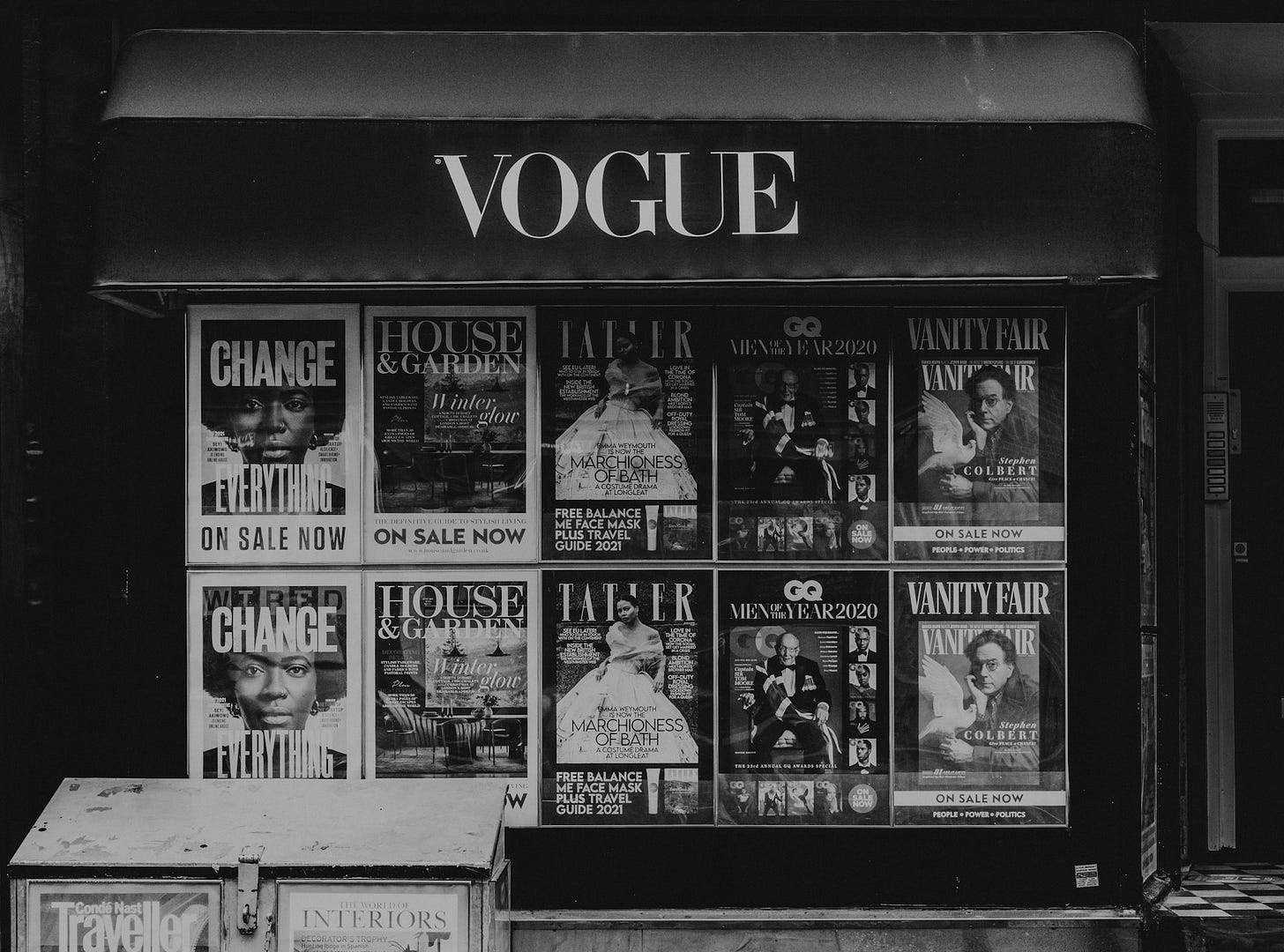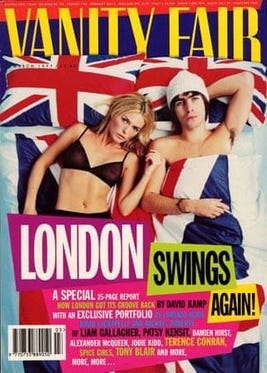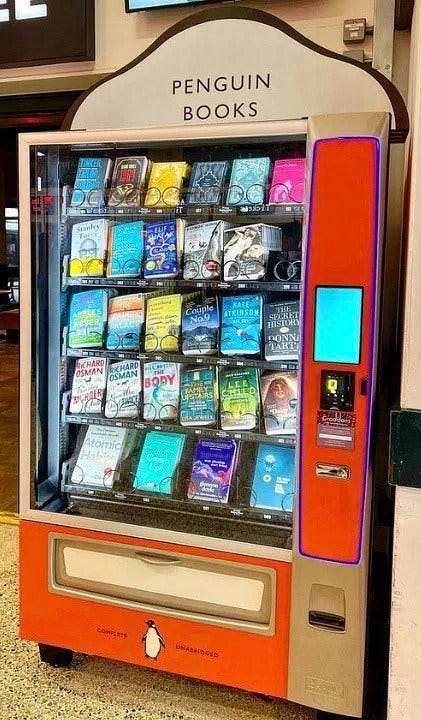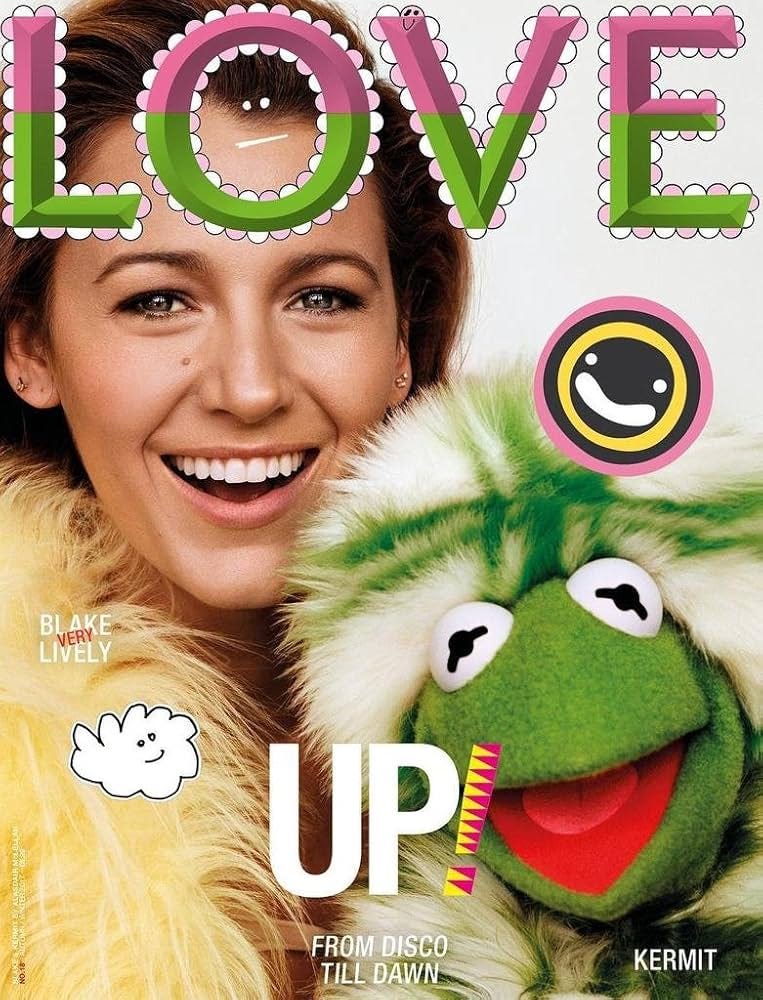A long post about two things I care about - books and magazines. I’m not putting it behind the paywall because I think this is an important topic we should all read and think about.
Here we go!
‘I think that magazines are mostly done,’ said iconic magazine editor Tina Brown earlier this week, in an excellent Substack interview with
.Not many people can argue with that. Even die-hard magazine fans like myself can admit that the industry is a shadow of its former self. The shelves in the magazine section of the supermarket are distinctly more threadbare than they used to be, household name publications have opted out of ABC auditing, year-on-year sales are down once again.
It makes me sad, because only twenty years ago, it was a such a different story.
I’d arrived in London to take up a job as junior writer on More magazine in the white heat of peak Britpop and Cool Britannia and couldn’t believe the wonderland I had fallen into in the name of work.
The entertainment industry was awash with money and happily threw it at magazines to promote their bands, solo artists and films and as an ‘on-staffer’ on one of the biggest selling national titles, it meant that I had some incredible experiences.
Over the years there were trips all over the world, staying in luxury hotels, just to meet the latest feted music industry star. You could get expense account taxis to watch a movie screening complete with free sandwiches in the middle of the day. Entertaining lunches were long and lavish. I watched the Monaco Grand Prix from a luxury yacht, went to Dolce & Gabbana’s 10th anniversary party in Milan to interview a singer who was performing there, and once flew to New York - just for the night - so I could attend the MTV music awards at Radio City Music Hall. Being a magazine journalist really was a dream job. Until it wasn’t.
There’s a great passage in Gone Girl when Nick Dunne explains his newly acquired unemployed status.
‘I arrived in New York in the late 90s, the last gasp of the glory days although no one knew it then. New York was packed with writers, loads of them. This was back when the Internet was still some exotic pet kept in the corner of the publishing world - throw some kibble at it, watch it dance on its little leash…it definitely won’t kill us in the night…’
But that’s exactly what happened. The internet changed everything.
Content was suddenly everywhere; it was easy to access without even leaving your house and the choice for the reader seemed infinite; there was something for every taste and mood.
Suddenly anyone could be a journalist - all they needed to do was send their blogs out into the world. And with the advent of Facebook and Instagram – practically everyone was dishing out their opinions to the universe. Who needed to buy newspapers and magazines to read their favourite columnists when you could find out what anyone thought about Big Brother simply by hopping on Twitter?
Most importantly of all, this content on the internet was free. For people who had spending months, years, training to be a professional journalist, it was very frustrating. Imagine what it was like for the people who owned the magazines.
The media companies didn’t quite sit back and do nothing. They launched digital versions of their brands too, but most of them, nearly all of them, were afraid to elevate themselves above the bloggers and the citizen journalists, and were not confident enough to charge for their content, at least in the early days.
And if you don’t value your content - why should anyone else?
Back in Printland, circulations started to plummet when competition from the internet started to bite and with it dipped the revenue from sales.
Maybe print magazines could have survived if the advertisers had stayed loyal, but when they discovered influencers who had metrics you could actually track and platforms like Facebook where you could target potential customers with precision, much of the ad spend moved on to them.
So it’s easy to blame the internet for the sad demise of print media, but it’s not the whole story.
Looking back, I think the rot set in pre social media, pre the dot.com boom and the advent of broadband, in about 1997.
Those days were the beginning of what I call the ‘cover-mount arms race’.
Cover-mounts, if you haven’t heard the term, are the free gifts that come attached to a magazine. I don't know who started the craze, but they became very popular, very quickly. These items were usually sourced in China – totes, make-up bags, t-shirts shrink wrapped in acres of plastic. By the turn of the millennium, when cover-mounts had proven they could give your sales figures a big old bump, the free gifts started to get more elaborate, more valuable and more widespread - so much so that going into WH Smith was like walking into a department store.
Sunglasses, flip-flops, bikinis - you name it, some magazine would have it strapped to the cover in the race to be the must-buy magazine on the news-stand. T-shirts suddenly had designer names emblazoned on the front of them, beauty products - lipsticks, brand-named mascara and nail polishes became especially popular. I even once saw a pair of HAIR STRAIGHTENERS on a front cover.
But by the time I was an editor, I remember watching somebody buy a copy of a top lifestyle magazine at Borders. I saw them pay for it, take the expensive beauty product freebie out of plastic wrapping and within a minute, they threw the magazine in the nearest bin.
You see, no amount of free stuff can save a mag if it is not truly connecting with its readers.
True, there were plenty of readers who loved both the free gift and the magazine - but in hindsight, the Noughties’ addiction to price-cutting and cover-mounting was just a sticking plaster, a quick fix to compete with the growing power of the internet and the change in people’s reading habits.
What publishers should really have been doing was doubling down on their investment in editorial, giving them added resources to build communities with their readers, helping them pivot more quickly into podcasts and video, promoting their journalists as experts, promoting magazines themselves, and the act of buying and reading them, as more desirable than scrolling.
Fast forward to 2025, and I hardly buy print magazines anymore. Truthfully, I stopped because my favourites no longer delighted and entertained me in the way they used to.
Titles I’d loved for years I found had become quite joyless; photoshoots felt edgy rather than magical, interviews were bland and obviously PR approved. Too much content felt politicised and preachy, which is not what I wanted from a lifestyle magazine. Financially squeezed, I noticed that magazines had become thin and expensive, certainly compared with the free and easy smorgasbord on the internet.
So I stopped my subscriptions because they simply weren’t giving me what I wanted. In the face of free unlimited content online, I just didn’t want magazines enough.
I don’t want this slide to happen to books.
I still love printed, physical products - my Kindle might be bursting, but I still buy dozens of hardbacks and paperbacks every year.
So thinking about why print magazines declined makes me wonder how we can stop it happening to physical books. Here are some thoughts…
Make books valuable
I've often drawn parallels with the publishing industry’s current devotion to the 99p ebook pricing strategy and the magazine cover-mount arms race.
After all, I'm sure I'm not the only one who has hundreds of 99p books sitting on their Kindle unread. These books were bought because they were a bargain, not necessarily because I was excited about the book.
Books can't be devalued. They can’t be just sold on price point. Not ebooks, not paperbacks, hardback or audio. They are all ‘books’ and their worth, a writer’s worth, needs to be protected.
Authors, editors, retailers need to work really hard to make sure the core product, the writing, the story, is as good as possible, especially when you are going to charge £10 for a physical edition.
Publishers should also not be afraid to charge more for books - although they have to make it worth it.
I’ll happily pay £70 for one of Assouline’s beautiful travel guides, especially when it’s from their delicious jet-set chic shop in Piccadilly. Yes - it’s very, very expensive but the act of buying it and browsing through it makes me feel like Sophia Loren.
Publishers need to make books look and feel exciting, exciting enough to compete shoulder to shoulder with podcasts, blogs and Netflix.
Make physical books desirable
I love ebooks. My publishing imprint is digital-first. You can have five hundred books in your handbag by loading the Kindle app on your phone. Kindles are also brilliant for holidays - no more lugging big books around in your suitcase. But as portable as ebooks are, there is still something special about a physical book. The smell of paper, the feel of it in your hands, the joy of ‘switching off’ from screen-time as you open a book.
Publishers should lean into this. Subscription boxes like FairyLoot are doing a roaring trade by providing stunning special editions with sprayed edges and foiled covers. Make books beautiful - a perfect gift for others or yourself.
Make bookshops and sales outlets magical
The other day Jack White’s Third Man Records store was voted one of the top record shops in the world. If you’ve been in it (it’s tucked away in Marshall St in Soho,) you won’t doubt why.
Conceived over lockdown to help keep gigs, live events and record buying alive, Third Man is a magical hub to the arts of buying and listening to music. It has bags of personality and is full of quirks that make it talked about and remarkable, like a token operated lucky dip machine and a recording booth where musicians can upload their work straight to vinyl.
Jack White has his White Stripes proceeds to invest in his passion project and he’s using them well - Third Man Records is leading the way in how physical product should be sold. Booksellers should look and learn - Penguin’s vending machines at various train stations are a great start.
Authors should build an engaged community
My husband and I were lucky enough to work for More and Loaded in their heyday. Readers flocked to our male model competitions, Chippendale shows and pub crawls. People would send letters to the office by the sackful, feeling a deep connection and belonging with the magazine.
More and Loaded (and many other successful titles,) weren’t just publications, they were communities and made people feel part of a tribe. Readers felt seen and understood and they were loyal, buying the magazine every issue.
Authors need to try and build communities too. They need to turn readers into loyal fans who will buy anything they put out. Live events, newsletters, and signed editions all help to do this. Their personal branding needs to be clear and stand for something.
Don’t be afraid of innovation
Glamour magazine launched in 2001. Looking back, it was when the internet was starting to gather steam. But no matter, Glamour flew out of the gates like a rocket and was soon one of the best-selling magazines in the country. It tapped into the zeitgeist with its Sex and the City sass, but its handbag format felt fresh, practical and distinctive, undoubtedly contributing to its success.
Book publishers should also embrace innovation. Personalized books are one way to go. Or fast, compulsive series - books released in quick succession to gain momentum, like the way Fifty Shades of Grey was published. Flipback books are also cool; printed on ultra-fine paper so they fit into the palm of your hand.
Make creative work-places FUN
In the Nineties, working at a magazine was brilliant fun. By and large, the whole team were pretty devoted to their jobs. Perks were spread around, we were happy to go out after hours and brainstorm features because honestly, it didn’t feel like work.
Compare that to an observation an old friend recently made. A highly experienced writer and editor, she had gone into a features department to do a shift and was shocked to see all the young journalists sitting there with headphones on, not interacting with anybody. There were no long boozy lunches in the pub talking about features, there seemed to be little enthusiasm for after hours socialising, in fact many of them left the office on the dot to go and do their side hustle.
You can sympathize. London rental prices are ridiculous, junior media salaries can be meagre, expenses almost non-existent. But creative environments need to have verve, energy and passion so that ideas can flow.
Teams need to collaborate and with remote working so in vogue, I’m not convinced staff are truly connecting and feeding off each others’ energy.
Cost cutting and redundancies aren’t long term business strategies. Publishing companies need to invest in people. Experienced editors should not be replaced by junior ones - teams need a balance of youthful energy and hard won wisdom.
Make work fun, make it enjoyable and staff will go the extra mile.
Make your writers feel valued.
As a publisher myself, I know it can be hard to make money from books. Compared to other sectors, the profit margins are low. A Facebook ad costs the same if you are marketing a £50,000 car or a £5 paperback. And the competition is fierce when thousands of books are published every year.
But still, authors have to feel valued.
Publishers need to make them feel as if they are being nurtured and supported in their careers - not just for their latest book. Editors need to be honest about expectations, because when a book doesn’t sell well, authors feel dejected, especially when they’ve been led to believe it would do well.
All this needs to happen, because the world of indie publishing is booming. Big name writers are on Substack, authors are exploring self-publishing in bigger and bigger numbers, especially in ebook formats.
Legacy media need to give creatives a reason to stay with them. Our words, our stories are the core product and with so much tech and freelance expertise at our fingertips, publishing ourselves isn’t difficult. Traditional publishers need to demonstrate what added value they bring to the table.
And for the record, I don't believe that the print magazine industry is dead. Radio Times and Good Housekeeping both turned 100 recently and remain the trusted brands they ever were. Reading The Simple Things is my monthly magazine fix for off-screen downtime - and we all want more of that.
I recently picked up a copy of The Oldie and loved the gentle humour and wisdom - even though I’m probably not the target demographic. You magazine and Stylist consistently come up with brilliant, innovative covers.
In fact, I think that’s the key to reviving magazines. Not being afraid to put out something fun, fabulous and original.
Meanwhile, on my recent trip to Tokyo, I saw that print magazines are still thriving. In Japan, magazines are seen as hip. I think that they are ahead of the curve on this one as I see Generation Z and Alpha rediscovering a love for print magazines in a way that millennials found vinyl.
Niche titles will thrive. Creative bravery will create desire and cool. I see the push back coming from independent creators - passionate young writers and designers every bit as committed to magazines as we were in the Nineties.
Here’s hoping.
Tasmina x
PS. I know that there are lots of writers and authors in the We Are All Creatives community. What do you think? I would love to hear everyone’s views. Especially magazine readers! Join the conversation :)












Great post. I too loved the Pandora x Tina article. I was on the other side of magazines- a marketeer- the landscape has changed so much and this is a fascinating read as to how writers are exploring the evolving world, thank you x
I miss magazines, they have are big part of teen years, from the days of being an avid reader of Mizz and Just Seventeen to Glamour and More in my 20's. I also now days find most magazines unless they are very niche are full of advertisements that I am not interested in.
Your post also reminded me of how lucky I was to have my work experience at Woman's Realm magazine (IPC Magazines) in the early 90's (edited at the time by Sally Sheringham) it felt like such a vibrant fun place to work and the team were absolutely lovely.